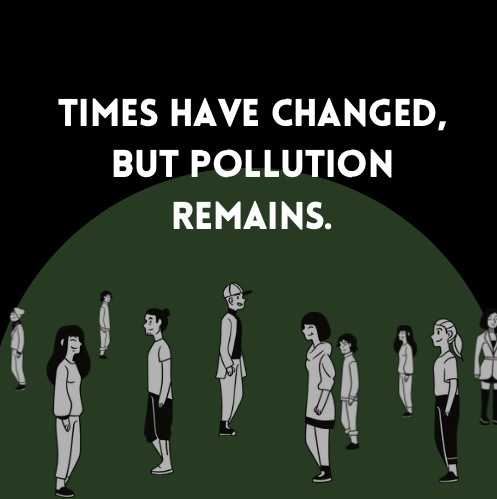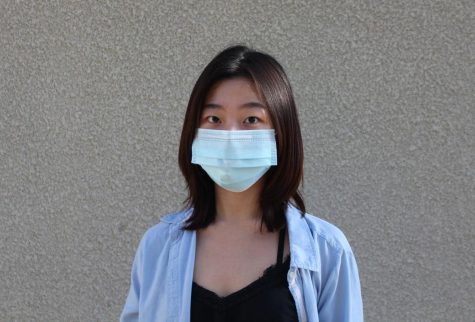The times have changed, but pollution remains: A look into the environmental hazards plaguing our community and the larger world

May 30, 2022
Environmental damage has been a repetitive topic in headlines, especially as the modern world has been forced to confront the consequences of its rapid industrialization and lack of foresight in dealing with the byproducts of manufacturing. Warnings of the heating atmosphere, climate change, plastics in oceans and more saturate the media, but these dire messages continue to fade into white noise. However, the problem is very real and has a significant impact on the residents of Santa Clarita today.
When people think of the meaning of pollution, they often consider it to be on the scale of oil spills or nuclear disasters. However, it is more common, and much closer than people think. Seemingly minor levels of substances accumulate and affect the average citizen more than is expected; the environmental crisis is not the hoax some make it out to be. I say this because the after effects of pollution have impacted my family and I on a personal level. My grandmother and family grew up in rural South Korea constantly exposed to carcinogens and other harmful chemicals from the factories and nuclear power plant installed in their village. They still suffer the effects now in the form of early cancers and organ failure. The oceans from which they made their living are already polluted beyond repair in some parts due to industrial waste. Times have changed, but the problem remains.
Over time, the perpetual progression of industrialization and unsustainable production stretched pollution’s effects from commercial areas to less-industrialized regions like the suburbs. Santa Clarita is no different, as pollution continues to be a major problem throughout the valley, due to factors like car exhaust and the irresponsible processing of industrial chemicals.
Air quality plummets annually in Santa Clarita every summer because of ground level ozone caused by chemical reactions from pollutants in the atmosphere—in fact, according to an article published by The Santa Clarita Valley Signal in 2020, the Santa Clarita Valley has one of the highest levels of ground level ozone in LA County.
Mrs. Solarez, the AP Environmental Science teacher at West Ranch explained why: “Ground level ozone comes mostly from combustion engines— driving cars. Ozone accumulates in a lot of different places as smog because it needs NOx, a chemical from cars, and sunlight to react with another chemical in the air. It tends to form in the afternoons. Levels are higher in Los Angeles and Santa Clarita because we’re a valley. Our topography traps the pollution in.” Ground level ozone, as opposed to stratospheric ozone, is harmful because it can disrupt the fragile balance of ecosystems, aggravate existing lung problems like asthma, and hinder breathing.
Another major concern in SCV, and the country, is of water being unfit to use. Many of the chemicals affecting Santa Clarita are commonly found in household items like cookware, cleaning products, and paper products.
Water sources concentrated in Los Angeles, Orange and Riverside counties have a concentration of contaminated wells, which has led to widespread criticism and action against companies that are the sources of these contaminants. In 2020, SCV Water filed a lawsuit against companies like Raytheon Technologies, Chemours and DuPont for introducing PFAS (per- and polyfluoroalkyl substances, chemicals to make products resistant to heat, water and grease) into the water supply. Seventeen wells owned by the regional company were closed down in 2019 due to the contamination discovered.
PFAS, also known as “forever chemicals”, aren’t able to break down in nature, instead building up in the ecosystem, humans and animals, killing them slowly. Mrs. Solarez elaborated, “These persistent chemicals stay with the water and go through the water cycle. The city is talking about suing these manufacturers because these chemicals are now in our groundwater, and they didn’t necessarily get there because they were dumped in the water but with rinsing and all the processes used in production, the wastewater wasn’t caught and cleaned enough, accumulating over time and leaching into the groundwater.” The Environmental Protection Agency has yet to set standards for PFAS.
These specific incidents are only partially indicative of the country as a whole. The effects of pollution have been seen far and wide, in all kinds of industries across the country. In the 1970s, the Love Canal neighborhood in New York discovered that homes and schools were built next to over 20,000 tons of toxic chemicals dumped by corporations, the city, and the U.S. Army, while only the most minor of warnings were included in the deeds of the land. Recently in Wisconsin, residents were advised to not eat fish from local lakes and rivers because of PFAS contamination (NPR 2021). Records from the state’s Department of Natural Resources have shown that the company responsible for a major part of the pollution had tested for high levels of perfluorinated chemicals on its property since 2013.
Several communities in Massachusetts have residents drinking bottled water because of high levels of toxins in public water sources. Michigan has a truly staggering amount of contamination due to its historical prominence in the automobile industry and abundance of factories.
The numbers are even more intimidating when one takes into account the countless other ways these chemicals enter the environment and affect people.
It is widely known that exposure to such chemicals is detrimental to human health, but the consequences of pollution are longer and farther reaching than one may think. According to the U.S. Census Bureau, over 360,000 U.S. children experience developmental or neurological problems due to exposure to toxic substances that are a byproduct of pollution. In addition to permanently reduced lung growth and capacity in children, exposure to pollution can inhibit brain development and increase the likelihood for one to have ADHD as well as birth defects. Adults can suffer reproductive harm and face high risk of cancer. In the Love Canal community, 56% of the children born from 1974 to 1978 possessed birth defects ranging from abnormal numbers of ears, extra rows of teeth and developmental disorders. The grown inhabitants of the region suffered miscarriages, developed narcosis, epilepsy and leukemia.
The PFAS found in contaminated water suppliers can lead to developmental delays in children, liver damage, increased risk of cancer, increased risk of obesity and interfere with the body’s hormone balance in higher levels.
Pollution disproportionately hurts the poor, because living spaces are always cheaper when no one with better means wants to live there. Areas near power plants, gas leaks, freeways and such have higher exposure to chemicals with neither the funds nor the time for those regions to be monitored and maintained at a regulation-safe state. Their residents are backed into an unfavorable position with no way out, stuck in a loop of cheaper but dangerous housing and ever-lowering prices that drop with the demographics of the community.
Racial disparities must also be taken into consideration when discussing the issue of environmental inequity because of the correlation found between one’s racial/ethnic group and socioeconomic position.
Racism, class bias and a lack of access to healthcare and better resources are all factors that increase a group’s susceptibility to harm from pollution. A national longitudinal study by researchers Paul Mohai of the University of Michigan and Robin Saha of the University of Montana found a pattern in which neighborhood transitions to a minority/lower income demographic tended to occur before the establishment of a hazardous waste facility in the vicinity. According to the American Lung Association, a study from 2017 “found that Hispanics and Asians, but especially blacks, had a higher risk of premature death from particle pollution than whites did.”
These communities are targeted by industries because they lack the resources and power to put up enough resistance against the establishment of environmental hazards. This, combined with discrimination in housing contribute to the statistics seen today.
Technology to purify and detect toxic chemicals in the environment exist, but applying them on the scale necessary to solve today’s problems would be impractical, due to its costliness and need for maintenance.
It is imperative that we spread awareness of the causes and effects pollution has on our community to prevent the damage from getting worse. Please use your rights as local residents to take action by increasing the city government’s priority on establishing stricter environmental regulation. Hold present leaders accountable by making your voices heard in protests or vote to choose the best candidate to help solve the problem. Responsibly recycle e-waste like batteries (found in smartphones, laptops, and most devices) and try to minimize your output of car exhaust. Society has an incredibly pessimistic view of its ability to fight something as large as climate change, but of course, nothing will change if nobody tries. Change is possible, but only if we work for it.

